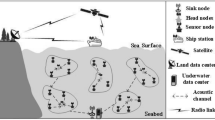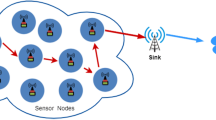Abstract
DV-Hop localization algorithm is a classic range free localization algorithm in wireless sensor networks (WSNs). Although easy to be employed in low cost and resource limited WSNs, DV-Hop localization algorithm suffers from low localization accuracy as the other range free localization approaches. To improve the localization accuracy, in this paper we introduce Bacterial Foraging Optimization (BFO), an efficient optimization method that has been widely applied in a variety of scientific and engineering applications. We conduct extensive simulations under different network setting, the simulation results demonstrate that the proposed algorithm achieves significantly higher positioning accuracy than the basic DV-Hop algorithm.






Similar content being viewed by others
References
Bermejo E, Cordon O, Damas S, Santamaria J (2013) Quality time-of-flight range imaging for feature-based registration using bacterial foraging. Appl Soft Comput 13(6):3178–3189
Bermejo E, Cordon O, Damas S, Santamaria J (2015) A comparative study on the application of advanced bacterial foraging models to image registration. Inf Sci 295:160–181
Bulusu N, Heidemann J, Estrin D (2000) Gps-less low-cost outdoor localization for very small devices. IEEE Pers Commun 7(5):28–34
Camilo T, Carreto C, Silva JS et al (2006) An energy-efficient ant-based routing algorithm for wireless sensor networks. In: International workshop on ant colony optimization and swarm intelligence. Springer, Berlin, pp 49–59
Devi S, Geethanjali M (2014) Application of modified bacterial foraging optimization algorithm for optimal placement and sizing of distributed generation. Expert Syst Appl 41(6):2772–2781
Doherty L, Pister K SJ, El Ghaoui L (2001) Convex position estimation in wireless sensor networks. In: Proceedings of IEEE INFOCOM, Anchorage, pp 1655–1663
Dulman S, Havinga P (2004) Statistically enhanced localization schemes for randomly deployed wireless sensor networks. In: DEST international workshop on signal processing for sensor networks, Australia
Guvenc I, Sahinoglu Z (2005) Threshold-based TOA estimation for impulse radio UWB systems. In: Proceedings of IEEE international conference on ultra-wideband, Zurich, pp 420–425
Hatami A, Pahlavan K, Heidari M, Akgul F (2006) On RSS and TOA based indoor geolocation—a comparative performance evaluation. In: Proceedings of IEEE wireless communications and networking conference, Las Vegas, pp 2267–2272
He T, Huang C, Blum BM, Stankovic AJ, Abdelzaher T (2003) Range-free localization schemes for large scale sensor networks. In: Proceedings of ACM MobiCom, San Diego, pp 81–95
Hongyang C, Sezaki K, Ping D et al (2008) An improved dv-hop localization algorithm with reduced node location error for wireless sensor networks. ieice transactions on fundamentals of electronics. Commun Comput Sci 91(8):2232–2236
Hou S, Zhou X, Liu X (2010) A novel DV-Hop localization algorithm for asymmetry distributed wireless sensor networks. In: IEEE international conference on computer science and information technology. IEEE, pp 243–248
Hu FS, Meng XQ (2011) Dv-hop localization algorithm of multi-dimensional average hopping value. Comput Eng Appl 47(28):42–44
Ji WW, Liu Z (2006) An improvement of DV-Hop algorithm in wireless sensor networks. In: International conference on wireless communications, networking and mobile computing, 2006 WiCOM. IEEE, pp 1–4
Kumar S, Lobiyal DK (2013) An advanced dv-hop localization algorithm for wireless sensor networks. Wirel Pers Commun 57(2):1365–1385
Lazos L, Poovendran R (2004) SeRLoc: secure range-independent localization for wireless sensor networks. In: ACM workshop on wireless security (WiSe)
Liu KZ, Wang S, Hu FP et al (2006) An improved dv-hop node location method in wireless sensor networks. Infect Control 35(6):787–792
Liu F, Zhang H, Yang J (2008) A weighted hop-based average distance estimation algorithm for wireless sensor networks. J Electron Inf Technol 30(5):1222–1225
Liu SF, Zhao QH, Wang HK (2009) Dvd-hop localization algorithm based on average hopping estimation and position correction. J Transduct Technol 22(8):1154–1158
Liu Z, Huang X, Hu Z, Khan MK, Seo H, Zhou L (2017) On emerging family of elliptic curves to secure internet of things: Ecc comes of age. IEEE Trans Dependable Secure Comput 14(3):237–248
Niculescu D, Nath B (2003) Ad hoc positioning system (APS) using AOA. In: Proceedings of IEEE INFOCOM, San Francisco, pp 1734–1743
Panda R, Naik MK (2015) A novel adaptive crossover bacterial foraging optimization algorithm for linear discriminant analysis based face recognition. Appl Soft Comput 30:722–736
Passion KM (2002) Biomimicry of bacterial foraging for distributed optimization and control. IEEE Control Syst Mag 22(3):52–67
Romer K (2003) The lighthouse location system for smart dust. In: ACM/USENIX international conference on mobile systems, applications, and services (Mo- biSys)
Stoleru R, He T, Stankovic JA, Luebke D (2005) A high-accuracy low-cost localization system for wireless sensor networks. In: ACM conference on embedded networked sensor systems (SenSys)
Stoleru R, He T, Stankovic JA (2007) Range-free localization. Secure localization and time synchronization for wireless sensor and ad hoc networks, pp 3–31
Tan L, Lin F, Wang H (2015) Adaptive comprehensive learning bacterial foraging optimization and its application on vehicle routing problem with time windows. Neurocomputing 151:1208–1215
Tao Y, Wang YL, Qiang G (2010) A DV-Hop localization algorithm based on average hopping weighting correction. In: International conference on management science and engineering
Verma OP, Hanmandlu M, Kumar P et al (2011) A novel bacterial foraging technique for edge detection. Pattern Recogn Lett 32(8):1187–1196
Wei X, Wang L, Wan J (2006) A new localization tech-nique based on network tdoa information. In: Proceedings of IEEE international conference on its telecommunications, Chengdu, pp 127–130
Yang C, Ji J, Liu J, Liu J, Yin B (2016) Structural learning of bayesian networks by bacterial foraging optimization. Int J Approx Reason 69:147–167
Acknowledgments
This research was supported by the Natural Science Foundation of China No.61640020.
Author information
Authors and Affiliations
Corresponding author
Rights and permissions
About this article
Cite this article
Zhou, C., Yang, Y. & Wang, Y. DV-Hop localization algorithm based on bacterial foraging optimization for wireless multimedia sensor networks. Multimed Tools Appl 78, 4299–4309 (2019). https://doi.org/10.1007/s11042-018-5674-5
Received:
Revised:
Accepted:
Published:
Issue Date:
DOI: https://doi.org/10.1007/s11042-018-5674-5




